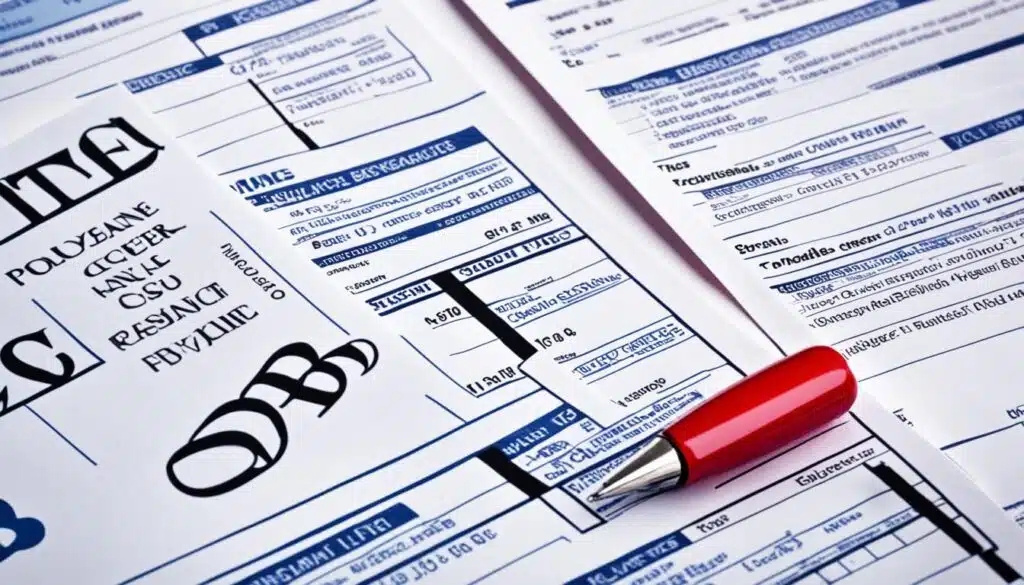Property insurance coverage is crucial for homeowners to protect their most valuable asset. Understanding the details of a policy is key to ensuring that your home and belongings are fully protected. In this section, we will provide an overview of the key components of property insurance coverage, including homeowners insurance, flood insurance, and the different types of coverage offered by insurance companies.
Key Takeaways:
- Homeowners insurance and flood insurance are essential components of property insurance coverage.
- There are different types of property insurance policies available, including commercial property insurance, standard homeowners insurance, renters insurance, and landlord insurance.
- Coverage limits and deductibles play a significant role in property insurance coverage.
- Additional coverage options and enhancements can provide more comprehensive protection.
- Assessing your coverage needs and choosing the right insurance company is essential for obtaining the best coverage.
The Basics of Homeowners Insurance
When it comes to protecting your home and belongings, homeowners insurance plays a crucial role. It provides coverage for various aspects of your property, ensuring financial security and peace of mind. Understanding the basics of homeowners insurance is essential in order to make informed decisions about your coverage needs.
Homeowners insurance consists of several components that work together to provide comprehensive protection. These components include:
Dwelling Coverage
Dwelling coverage is the foundation of homeowners insurance. It protects the structure of your home, including the walls, roof, foundation, and attached structures like garages or porches. In the event of damage caused by covered perils such as fire, vandalism, or severe weather, dwelling coverage helps cover the costs of repairs or rebuilding.
Personal Property Coverage
Personal property coverage extends beyond the physical structure of your home to protect your belongings. This includes furniture, appliances, electronics, clothing, and other valuable items. If these items are damaged, destroyed, or stolen due to covered risks such as theft, fire, or vandalism, personal property coverage helps reimburse you for their value.
Liability Coverage
Liability coverage is a crucial component of homeowners insurance as it provides financial protection in case someone gets injured on your property or if you accidentally cause damage to someone else’s property. If you are held legally responsible for such incidents, liability coverage helps cover the associated medical bills, legal fees, and property repairs.
Having all three components of homeowners insurance ensures comprehensive coverage for your property and personal interests. It safeguards your home, belongings, and finances against unexpected events and liabilities.
It’s important to note that homeowners insurance policies can vary in terms of coverage limits and exclusions, so it’s advisable to carefully review your policy documents and consult with your insurance provider to understand the specific details of your coverage.
In the next section, we will explore flood insurance, which is a specialized type of coverage that provides protection against flood-related damages.
Understanding Flood Insurance
Flood insurance is a specialized type of property insurance coverage that provides protection against flood-related damages. It is crucial for property owners, especially those in flood-prone areas, to consider purchasing flood insurance to safeguard their investments. The National Flood Insurance Program (NFIP) offers flood insurance coverage for residential and commercial properties, ensuring that property owners have access to the necessary protection.
Floods can cause extensive damage to homes and other properties, resulting in significant financial losses. Without adequate flood insurance, property owners may face difficulties in recovering from such losses. This is where flood insurance plays a vital role, providing coverage specifically designed to address flood-related damages.
The National Flood Insurance Program (NFIP) is a federal program administered by the Federal Emergency Management Agency (FEMA). It was established to help property owners obtain flood insurance coverage as flood-related damages are not typically covered by standard homeowners insurance policies. NFIP flood insurance policies are available to property owners across the United States, regardless of whether their property is located in a high-risk flood zone or not.
Flood insurance coverage provided by the NFIP encompasses various aspects, including structure coverage, which protects the physical structure of the building, and content coverage, which safeguards the belongings stored within the property. It is essential for property owners to understand the specifics of their flood insurance policy and ensure that they have adequate coverage for both structural and content damages that may occur due to flooding.
Flood Insurance Coverage Components
An NFIP flood insurance policy typically includes coverage components such as:
- Dwelling Coverage: Provides protection for the structure of the property, including the foundation, walls, electrical systems, plumbing, and heating/cooling systems.
- Contents Coverage: Protects personal belongings, including furniture, appliances, clothing, and other items damaged by floodwaters.
- Replacement Cost Coverage: Offers compensation for the full replacement cost of damaged structures or belongings, without considering depreciation.
- Actual Cash Value Coverage: Provides compensation based on the actual cash value of the damaged structures or belongings, considering depreciation.
Having flood insurance coverage not only safeguards property owners from financial losses but also provides peace of mind. With the increasing frequency and severity of floods in many areas, protecting one’s assets with flood insurance is a wise investment.
| Benefits of Flood Insurance | Dangers of Uninsured Flooding |
|---|---|
| Financial protection against flood-related damages | Potential loss of property value |
| Coverage for repairs and rebuilding | Costly repairs and restoration expenses |
| Peace of mind knowing your property is protected | Emotional stress and uncertainty |
Different Types of Property Insurance Coverage
Property insurance coverage encompasses various types of policies tailored to different property types. Whether you own a commercial property, residential property, or rent a property, there are specific insurance options available to meet your needs. This section will delve into the different types of property insurance coverage, including commercial property insurance, standard homeowners insurance, renters insurance, and landlord insurance.
Commercial Property Insurance
Commercial property insurance is designed for businesses that own or lease commercial properties. It provides coverage for buildings, contents, and liability associated with the property. Business owners can protect their assets from perils such as fire, theft, and natural disasters, ensuring their operations can swiftly recover from unexpected events.
Standard Homeowners Insurance
Standard homeowners insurance is the most common type of property insurance for residential properties. It offers coverage for both the structure of the home and personal belongings. This insurance also provides liability protection in case someone gets injured on the property. Homeowners can choose between different coverage options and endorsements to tailor their policy to their specific needs.
Renters Insurance
Renters insurance is designed for tenants who rent their living spaces. This insurance protects tenants’ personal belongings against perils such as theft, fire, and vandalism. Additionally, renters insurance provides liability coverage in case the tenant accidentally damages the rental property or causes harm to others on the premises.
Landlord Insurance
Landlord insurance is essential for property owners who rent out residential properties. This insurance protects the property owner’s investment by covering the structure of the building, liability risks associated with the rental property, and potential loss of rental income. Landlords can tailor their policies to include additional coverage options such as landlord liability and rental property contents coverage.
Now that you have gained an understanding of the different types of property insurance coverage, let’s take a closer look at coverage limits and deductibles in the next section.
| Type of Insurance | Covered Property Type |
|---|---|
| Commercial Property Insurance | Commercial Properties |
| Standard Homeowners Insurance | Residential Properties |
| Renters Insurance | Rented Residences |
| Landlord Insurance | Rental Properties |
Coverage Limits and Deductibles
When it comes to property insurance coverage, it’s important to understand the concepts of coverage limits and deductibles. Coverage limits refer to the maximum amount that an insurance company will pay for a covered loss. On the other hand, deductibles are the amount that policyholders must pay out of pocket before their insurance coverage kicks in.
Let’s take a closer look at each of these aspects:
Coverage Limits
Coverage limits play a crucial role in determining the level of protection provided by your property insurance policy. These limits can vary depending on the type of coverage and the specific policy. It’s essential to review your policy carefully to ensure that you have adequate coverage for your property and belongings.
For example, if you have a homeowners insurance policy, the coverage limit for your dwelling may differ from the coverage limit for your personal property. Understanding these limits will help you determine the extent of your coverage and ensure that you’re adequately protected.
Deductibles
Deductibles are the amount policyholders are responsible for paying before their insurance coverage starts. These out-of-pocket expenses help reduce insurance fraud and keep premiums affordable. When choosing a deductible, it’s a balancing act between the amount you’re willing and able to pay upfront and the impact it can have on your monthly insurance premiums.
Here’s how it works: Let’s say you have a $1,000 deductible and experience a covered loss of $5,000. In this case, you would need to pay the $1,000 deductible, while your insurance company would cover the remaining $4,000.
Did you know? Some insurance policies may have separate deductibles for different types of losses. For example, a homeowners insurance policy may have a separate deductible for wind and hail damage compared to other perils.
Replacement Cost Coverage vs. Actual Cash Value Coverage
When it comes to property insurance coverage, it’s crucial to understand the difference between replacement cost coverage and actual cash value coverage.
Replacement cost coverage provides coverage for the cost of replacing damaged or destroyed property without factoring in depreciation. It allows you to replace your damaged property with a new one of similar quality and features.
Actual cash value coverage, on the other hand, factors in depreciation when determining the payout for a covered loss. This means that the insurance company will consider the age, condition, and market value of the damaged property at the time of the loss.
Here’s a comparison:
| Replacement Cost Coverage | Actual Cash Value Coverage |
|---|---|
| Does not factor in depreciation | Factors in depreciation |
| Allows you to replace damaged property with a new one | Provides coverage based on the current market value of the damaged property |
| May have higher premiums | May have lower premiums |
Understanding the difference between these two types of coverage can help you make informed decisions about what type of coverage best suits your needs and budget.

Additional Coverage Options and Enhancements
Property insurance policies offer a range of additional coverage options and enhancements to ensure comprehensive protection for policyholders. These options go beyond the standard coverage provided and can be tailored to specific needs and circumstances. Let’s explore some of the additional coverage options and enhancements available in property insurance policies:
1. Additional Living Expenses Coverage
One valuable addition to property insurance coverage is the option for additional living expenses coverage. This coverage helps policyholders cover the costs of temporary relocation due to a covered loss. In the event that your property becomes uninhabitable, additional living expenses coverage can provide financial support for alternative accommodations, meals, and other necessary expenses.
2. Loss of Use Coverage
Loss of use coverage is another important enhancement offered by property insurance policies. This coverage provides reimbursement for expenses incurred when your property is uninhabitable due to a covered loss. It can help cover the costs of accommodations, meals, transportation, and other necessary expenses while repairs or rebuilding is underway.
Loss of use coverage ensures that you have the financial means to maintain your standard of living and fulfill your daily needs even when your property is temporarily unavailable.
3. Comprehensive Property Insurance
Comprehensive property insurance is a more extensive form of coverage that includes a wide range of perils and events. It provides an additional layer of protection beyond the standard perils covered in a basic homeowners insurance policy.
With comprehensive property insurance, policyholders can have peace of mind knowing that their property is protected against a broader spectrum of risks, such as fire, theft, vandalism, and natural disasters, depending on the specific policy terms.
Comprehensive property insurance is especially valuable for homeowners who want maximum protection for their property and belongings.

| Additional Coverage Options and Enhancements | Description |
|---|---|
| Additional Living Expenses Coverage | Provides financial support for temporary relocation expenses due to a covered loss. |
| Loss of Use Coverage | Reimburses policyholders for expenses incurred when their property is uninhabitable. |
| Comprehensive Property Insurance | Offers broader protection against a wide range of perils and events beyond the standard coverage. |
The additional coverage options and enhancements in property insurance policies allow policyholders to tailor their coverage to their specific needs and provide extra protection for unforeseen circumstances. By adding these options to their policy, homeowners can ensure comprehensive coverage, minimizing potential financial burdens in the face of unexpected events.
Understanding Liability Coverage
Liability coverage is a critical aspect of property insurance that provides vital financial protection in case of unexpected incidents. It safeguards policyholders if someone gets injured on their property or if they accidentally cause damage to someone else’s property. Let’s explore the different aspects of liability coverage, including personal liability and premises liability, and understand how it offers coverage for injuries or property damage caused by the policyholder.
Personal Liability
Personal liability coverage is an essential component of property insurance. It protects policyholders from legal and financial consequences if they are found legally responsible for causing bodily injuries or property damage to others. This coverage extends beyond incidents that occur at the policyholder’s residence and may also cover incidents that happen elsewhere, such as a neighbor’s property or at a public event.
Premises Liability
Premises liability coverage is specifically designed to protect policyholders from liability claims arising from injuries sustained by others while on their property. Whether it’s a slip and fall accident, a dog bite, or any other injury, premises liability coverage ensures that the policyholder has financial protection in place. Additionally, premises liability coverage may also extend beyond the physical structure of the property to cover damages caused by the policyholder’s negligence, such as a tree falling on a neighbor’s car.
Having liability coverage offers peace of mind and protects policyholders from the potentially devastating financial consequences of accidents or incidents on their property. It is essential to review the details of your property insurance policy to understand the limits and exclusions of your liability coverage.
“Liability coverage provides financial protection if someone gets injured on your property or if you accidentally cause damage to someone else’s property.”
Now that we have covered liability coverage, let’s move on to the next section and explore assessing coverage needs and how to choose the right insurance company.

Assessing Coverage Needs and Choosing an Insurance Company
When it comes to obtaining the best property insurance coverage, assessing your coverage needs and selecting the right insurance company are vital steps. By carefully evaluating your requirements and comparing options, you can ensure that you choose a policy that meets your specific needs. Here’s a guide on how to assess your coverage needs, evaluate insurance companies, obtain insurance quotes, and explore coverage options.
Assess Your Coverage Needs
Before selecting an insurance policy, it’s crucial to assess your coverage needs. Consider factors such as the value of your property, the cost of rebuilding or replacing it, and the value of your personal belongings. Take into account any unique risks associated with your property or location, such as flood-prone areas or high crime rates. By understanding your coverage needs, you can make informed decisions about the type and level of insurance that best protects your assets.
Compare Insurance Companies
Once you’ve assessed your coverage needs, it’s time to compare insurance companies. Look for reputable insurance providers with a strong financial standing and a history of reliable claims processing. Consider factors such as customer reviews, complaint ratios, and industry ratings to gauge the reputation and reliability of different companies. It’s also beneficial to seek recommendations from friends, family, or trusted advisors who have had positive experiences with insurance companies.
Obtain Insurance Quotes
Obtaining insurance quotes from multiple companies is essential to ensure you get the best coverage at a competitive price. Request quotes based on your specific coverage needs and provide accurate information to receive accurate estimates. Compare the quotes, taking into account the coverage provided, deductibles, and any applicable discounts. Don’t be afraid to ask questions and seek clarification on any unclear aspects of the quotes.
Evaluate Coverage Options
As you evaluate different insurance companies and their quotes, carefully consider the coverage options available. Look beyond the basic coverage to see if there are any additional options that may enhance your policy. For example, some insurers offer optional endorsements for specific risks or increased coverage limits. Evaluate these options based on your needs and budget, considering their potential benefits and costs.
| Important Considerations When Choosing an Insurance Company: |
|---|
| Financial stability: Ensure the company has a strong financial standing to meet its obligations. |
| Claims processing: Research the company’s reputation for handling claims promptly and efficiently. |
| Customer service: Look for companies that provide excellent customer support and timely responses to inquiries. |
| Discounts and incentives: Check if the company offers any discounts or incentives that can help reduce your premiums. |
By assessing your coverage needs, comparing insurance companies, obtaining quotes, and evaluating coverage options, you can make a well-informed decision when choosing an insurance company and policy. Taking the time to research and analyze different options will help you secure the best property insurance coverage that aligns with your specific needs and provides peace of mind.

Understanding the Claims Process
When it comes to property insurance coverage, understanding the claims process is crucial. Filing a claim and navigating the process effectively can help you maximize the benefits of your insurance policy. In this section, we will walk you through the steps involved in filing a claim, provide tips for a smooth and timely claim settlement, and discuss the necessary documentation to support your claim.
Also Read:- Beyond The Storm: Diverse Strategies For Natural Disaster Property Insurance
Filing a Claim
When an unfortunate event occurs that leads to property damage or loss, filing a claim is the first step you should take to initiate the insurance reimbursement process. To file a claim, follow these steps:
- Contact your insurance company: Notify your insurance company as soon as possible. They will guide you through the specific requirements and documentation needed for your claim.
- Provide necessary information: Be prepared to provide details about the incident, including the date, time, location, and a description of the damage or loss incurred.
- Document the damage: Take photos or videos of the damage, if it is safe to do so. This visual evidence will help support your claim.
- Complete the claim form: Fill out the claim form provided by your insurance company. Be thorough and accurate when providing information.
- Submit supporting documentation: Include any relevant documentation, such as police reports, repair estimates, invoices, or receipts to support your claim.
Claim Settlement and Documentation
Once you’ve filed a claim, the insurance company will assign an adjuster to evaluate the damage and assess the validity of your claim. The adjuster will review the information and documentation provided and may conduct an on-site inspection if necessary.
“To ensure a smooth and timely claim settlement, it is essential to provide accurate and comprehensive documentation of the damage or loss.”
The documentation required may vary depending on the nature and extent of the claim. It typically includes:
- Proof of ownership: Provide documents that establish your ownership of the property or belongings affected by the claim, such as receipts, purchase contracts, or appraisals.
- Receipts and invoices: Keep copies of receipts and invoices for any repairs, replacements, or expenses related to the claim.
- Medical reports and bills: If the claim involves injuries, include medical reports and bills to support the medical expenses incurred.
- Loss of income documentation: If the claim relates to a business interruption, include documentation of lost income or profits as a result of the incident.
- Any other relevant documentation: Provide any additional documentation that supports your claim, such as witness statements, expert opinions, or incident reports.
By gathering and submitting accurate and comprehensive documentation, you can strengthen your claim and increase the likelihood of a fair settlement. It is crucial to keep copies of all documents and receipts for your records.

Conclusion
Protecting your assets with property insurance coverage is essential for ensuring peace of mind. Throughout this article, we have explored the various components of property insurance coverage, including homeowners insurance, flood insurance, and additional coverage options. By understanding policy details and assessing your coverage needs, you can safeguard your home and belongings against potential risks.
With comprehensive property insurance coverage, you can rest easy knowing that your assets are protected. Homeowners insurance provides crucial coverage for the structure of your home, personal belongings, and liability. Flood insurance, on the other hand, offers vital protection against flood-related damages. By considering these coverage options and enhancements, such as additional living expenses coverage and loss of use coverage, you can enhance your insurance package.
It is important to evaluate your coverage needs and choose an insurance company that aligns with your specific requirements. Comparing insurance companies, obtaining quotes, and reviewing coverage options can help you make an informed decision. Additionally, understanding the claims process and effectively navigating it can ensure a smooth and timely claim settlement.
By prioritizing property insurance coverage, you are taking proactive steps to protect your assets and achieve peace of mind. With the right coverage in place, you can mitigate financial risks and have the confidence that your property is adequately safeguarded.
FAQ
A: Property insurance coverage is a type of insurance policy that provides financial reimbursement to the owner or renter of a structure and its contents in the event of damage or theft. It typically includes coverage for a variety of risks such as fire, theft, and natural disasters.
Q: What does homeowners insurance cover?
A: Homeowners insurance typically covers damage to the dwelling, personal property, liability protection, and additional living expenses in case the home is uninhabitable. It may also cover other structures on the property, like a garage or shed.
Q: How does property insurance work?
A: Property insurance works by the policyholder paying a premium to the insurance company in exchange for coverage. If there is a covered loss, the insurance company will reimburse the policyholder up to the limits outlined in the policy.
Q: What types of coverage are available in property insurance policies?
A: Property insurance policies may include coverage for fire, theft, vandalism, natural disasters, and liability. Additionally, specific policies like earthquake insurance or mobile home insurance can be added for additional protection.
Q: Where can I get a homeowners insurance quote online?
A: Many insurance companies offer online quotes for homeowners insurance. You can visit their websites, enter the necessary information about your property, and receive a quote instantly.
Q: What is fire insurance and how does it factor into property insurance?
A: Fire insurance is a type of coverage that specifically protects against losses caused by fire. It is often included in standard property insurance policies to provide financial protection in case of a fire-related incident.
Q: How is property protection different for commercial property coverage?
A: Commercial property coverage is designed for businesses and typically includes protection for buildings, equipment, inventory, and liability. It is tailored to the unique risks faced by commercial properties compared to residential properties.
Source Links
- https://fastercapital.com/content/Sublimits–Beyond-the-Surface–Unraveling-Sublimits-and-Split-Limits.html
- https://www.linkedin.com/pulse/unraveling-layers-homeowners-insurance-comprehensive-lpzsf
- https://medium.com/@LibraReview/unraveling-the-mysteries-of-insurance-the-art-of-protection-and-peace-of-mind-c8f4e4fa3dbe




